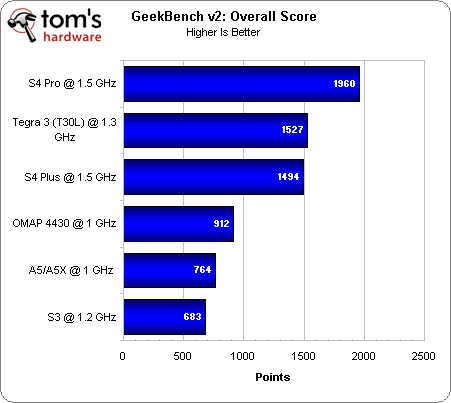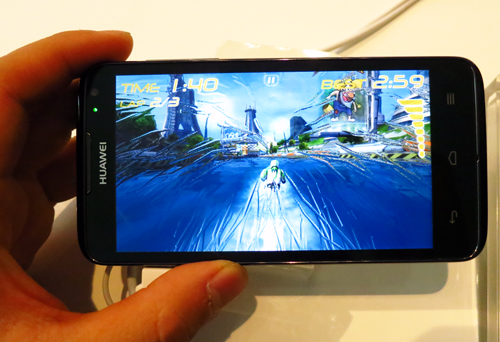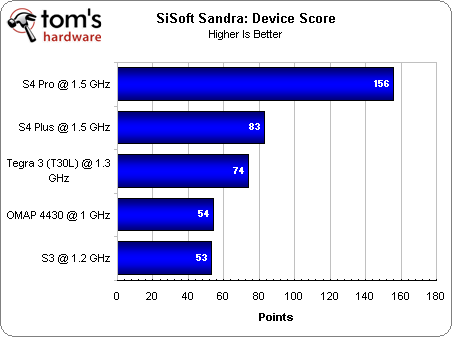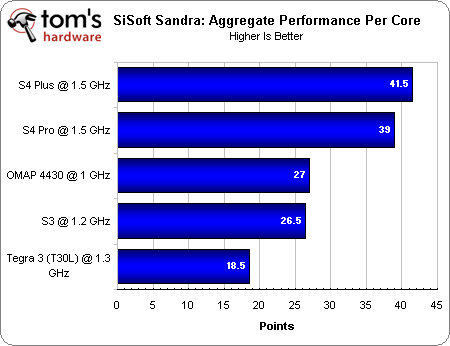Snapdragon S4 Pro: Krait And Adreno 320, Benchmarked
Performance From Scorpion To Krait: What A Difference One Generation Makes
GeekBench v2
Beyond the speeds and feeds, how do the performance of Qualcomm's Scorpion and Krait cores differ? GeekBench can help us out with a general assessment.
| GeekBench Scores | |||
|---|---|---|---|
| SoC | Integer | Floating-Point | Memory |
| Nvidia Tegra 3 (T30L)(Four Cortex-A9 Cores @ 1.3 GHz) | 1298 | 2288 | 1222 |
| TI OMAP 4430(Two Cortex-A9 Cores @ 1 GHz) | 750 | 1298 | 853 |
| Apple A5/A5X(Two Cortex-A9 Cores @ 1 GHz) | 691 | 921 | 830 |
| Qualcomm S3 (APQ8060)(Two Scorpion Cores @ 1.2 GHz) | 594 | 708 | 946 |
| Qualcomm S4 Plus (MSM8960)(Two Krait Cores @ 1.5 GHz) | 964 | 2251 | 1666 |
| Qualcomm S4 Pro (APQ8064)(Four Krait Cores @ 1.5 GHz) | 1400 | 3292 | 1276 |
According to our numbers, Krait nearly triples the performance of its predecessor, with the biggest gain seen in floating-point performance. Also interesting is the comparison between Krait and Nvidia's Tegra 3, which drives tablets like the Nexus 7 and Transformer Pad.
Strong floating-point performance is a notable boon for game developers, and we hope that Qualcomm's strength in this discipline serves to further the work being done in mobile gaming. Google's own Android documentation recommends judicious use of floating-point math, since it's about 2x slower than integer math on Android-based devices. And yet, we see TI's OMAP 4430 outmaneuver Apple's A5/A5X in GeekBench's floating-point metric, despite the fact that they both employ dual Cortex-A9 cores at 1 GHz. So, what's that say about performance under iOS?
Although software developers are still tied to programming for multiple hardware platforms, some faster and some slower, it's entirely possible that, in some situations, Krait-based devices will offer the best performance currently available.
SiSoft Sandra, Android Edition
Sandra is one of those diagnostic tools that lets us dig a little deeper on the desktop, isolating specific performance characteristics in a granular way. SiSoftware eventually plans to release an Android-specific version of the software, but the company granted us exclusive access to an early beta copy for our story today.
Get Tom's Hardware's best news and in-depth reviews, straight to your inbox.
| SiSoftware Sandra Aggregate Performance | |||||
|---|---|---|---|---|---|
| Row 0 - Cell 0 | OMAP 4430 | Tegra 3 (T30L) | S3(APQ8060) | S4 Plus(MSM8960) | S4 Pro(APQ8064) |
| CPU | Two Cortex-A9 Cores @ 1 GHz | Four Cortex-A9 Cores @ 1.3 GHz | Two Scorpion Cores @ 1.2 GHz | Two Krait Cores @ 1.5 GHz | Four Krait Cores @ 1.5 GHz |
| Native Arithmetic (MOPS) | 463 | 1133 | 365 | 593 | 1194 |
| Native Multi-media (kPix/s) | 2301 | 5912 | 3297 | 5067 | 9642 |
| Java Arithmetic (MOPS) | 90 | 225 | 86 | 171 | 278 |
| Memory (MB/s) | 603 | 968 | 1265 | 3308 | 4104 |
Naturally, the quad-core architectures are at an inherent advantage in any threaded workload. So, we also run aggregate performance-per-core tests to zero in on the capabilities of each computational building block.
Again, the S4 Pro platform's Krait processor takes a commanding lead over the Cortex-A9- and Scorpion-based competition.
| Aggregate Performance-Per-Core | |||||
|---|---|---|---|---|---|
| Row 0 - Cell 0 | OMAP 4430 | Tegra 3 (T30L) | S3 (APQ8060) | S4 Plus (MSM8960) | S4 Pro (APQ8064) |
| CPU | Two Cortex-A9 Cores @ 1 GHz | Four Cortex-A9 Cores @ 1.3 GHz | Two Scorpion Cores @ 1.2 GHz | Two Krait Cores @ 1.5 GHz | Four Krait Cores @ 1.5 GHz |
| Native Arithmetic (MOPS/Thread) | 231.5 | 283.2 | 182.5 | 296.5 | 298.5 |
| Native Multi-media (kPix/s/Thread) | 1150.5 | 1478.0 | 1648.5 | 2533.5 | 2410.5 |
| Java Arithmetic(MOPS/Thread) | 45.0 | 56.2 | 43.0 | 85.5 | 69.5 |
| Memory (MB/s/Thread) | 301.5 | 242.0 | 632.5 | 1654.0 | 1026.0 |
Current page: Performance From Scorpion To Krait: What A Difference One Generation Makes
Prev Page Qualcomm's Snapdragon S4 Line-Up: Krait CPUs And Adreno Graphics Next Page Nitty Gritty: CPU Core Performance, Per Clock-
shotgunz Naw, more like give foxconn workers better salary, do something good with mountain of money they have, stop patent trolling, stop silly war with google/samsung and stop lieing. Then maybe Apple will be forgiven.Reply -
luciferano shotgunzNaw, more like give foxconn workers better salary, do something good with mountain of money they have, stop patent trolling, stop silly war with google/samsung and stop lieing. Then maybe Apple will be forgiven.Reply
Well, it'd be a start. I wouldn't go nearly as far as all is forgiven. -
mayankleoboy1 AFAIUI, the PowerVR GPU in ipad3 is more of a brute force architecture. "Just throw more transistors" is its mantra. So its good in current workloads.Reply
The Adreno320 is more refined and optimised arch. Trying to get the most performance from least silicon area. It is still being refined. Hence, it will do well in future applications. -
Why the ST-ericsson 8500 isn't in this list either? too few phone out? Xperia S/P... looks it would rock some of concurrents.. omap..S3...Reply
Please be as exaustive as possible ;) -
Error in the chart on second page.Reply
The cortex A15 DMIPS/MHz should read above the A9. Around 3.5 DMIPS/MHz from the rumblings. -
These krait numbers aren't very impressive if you normalize for clockspeeds.Reply
In fact, they seem to suggest only a very small improvement over A9, if any at all.



